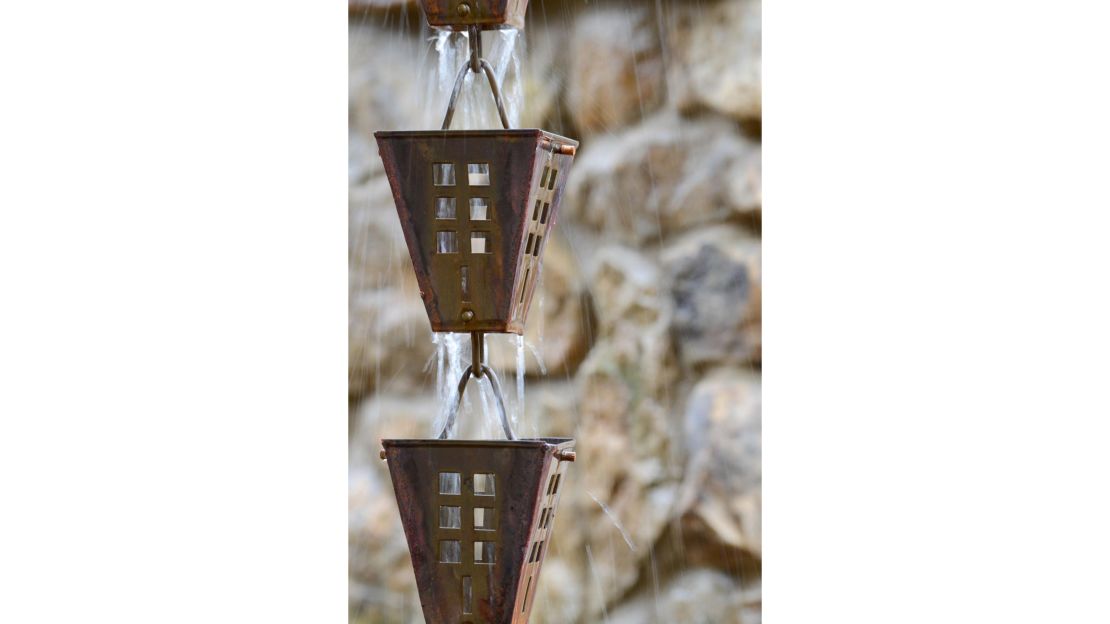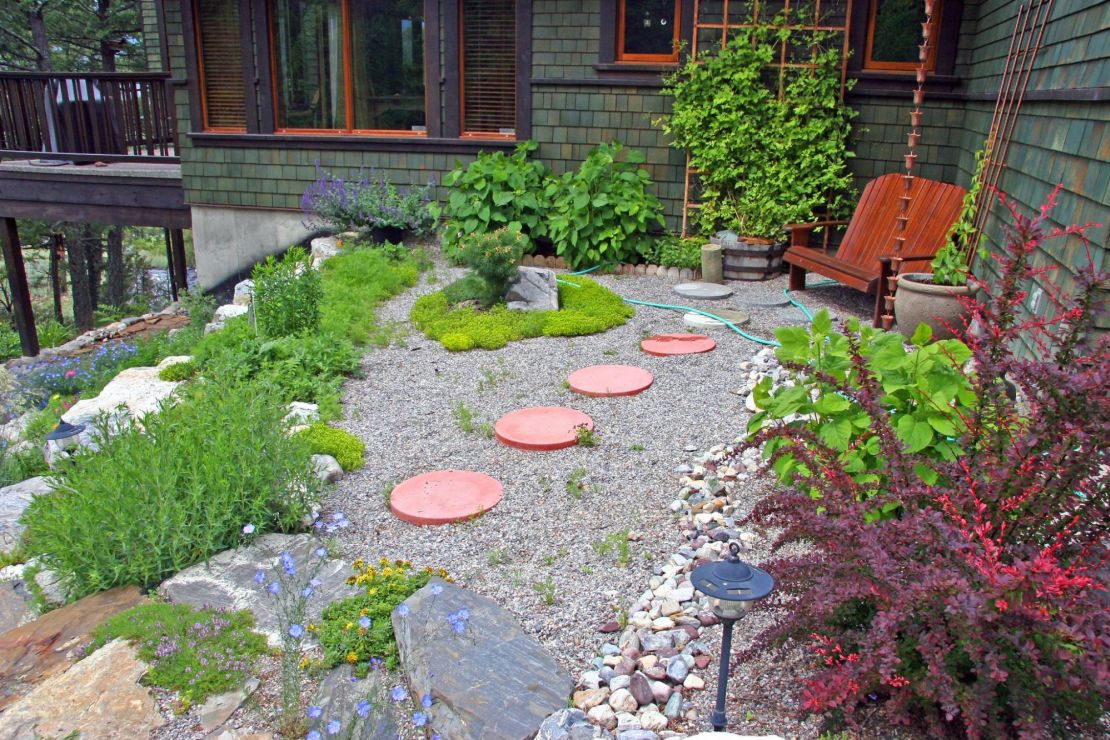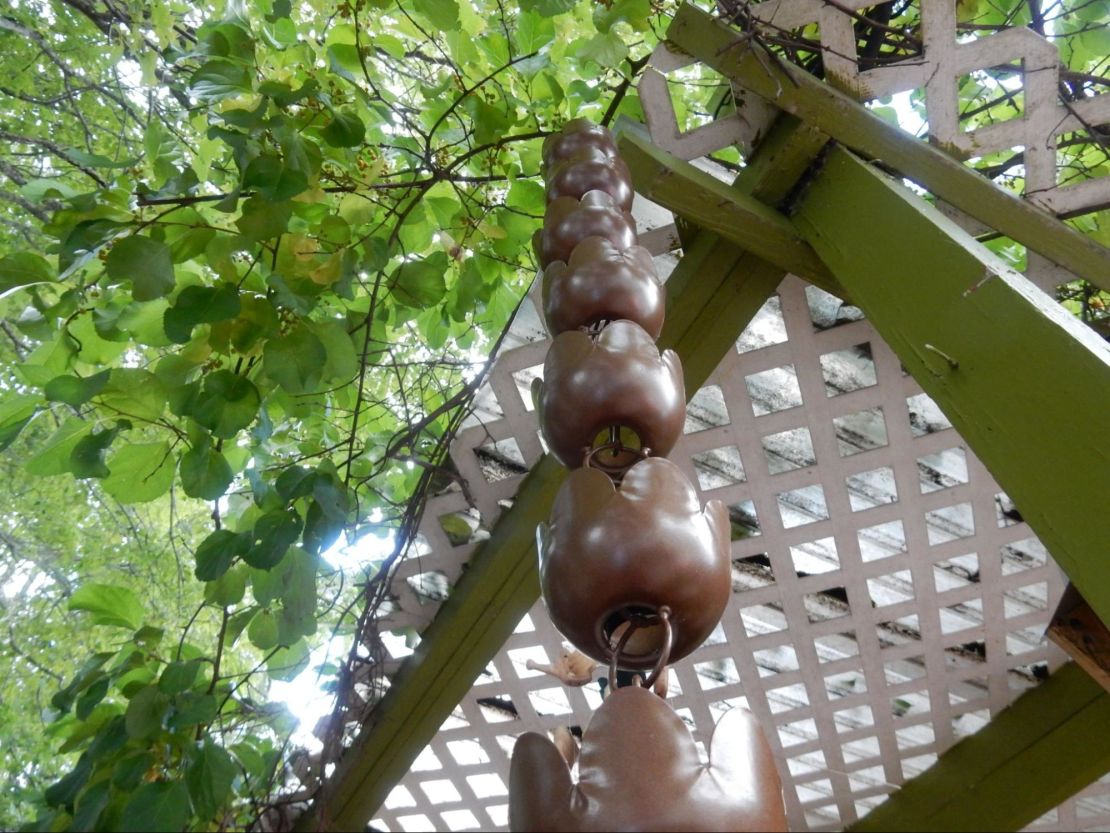Rain chains are a unique and practical way to protect your home from rainwater. Sometimes called gutter chains, these chain links, cups or funnels move rainwater from your rooftop to the ground.
In the right climate, a rain chain can be an excellent alternative to a downspout. Replacing downspouts with rain chains can also add curb appeal, help with water conservation, and be the perfect addition to your home’s gutter and gutter guard system. Learn how rain chains work and if they’re the right option for your home.
Key takeaways
Rain chains add aesthetic appeal to your home while also protecting your home from water damage.
Rain chains aren’t recommended for areas with heavy rainfall and are best suited for climates with mild to moderate rainfall.
Rain chain installation can be a DIY project, saving you money.
What is a rain chain?
Rain chains are decorative cups linked together to form an attractive downspout. They are an alternative to gutters for draining rainwater. Rain chains originated in Japan in the 1500s. Now gaining popularity in the United States, they help direct rainwater from a roof to the ground and away from a foundation.
“Rain chains create a soothing visual and auditory experience as rainwater cascades down the chain, which some people prefer over a downspout rush,” said Jane Dobbs, a team lead for gardening at Allan’s Gardeners in the United Kingdom.
How does a rain chain work?

A rain chain attaches to your gutter similarly to a downspout. As rain falls into the gutters, surface tension allows the water to drain down the rain chain toward the ground. If your home doesn’t have gutters, you should attach a rain chain to your eaves.
Once a rain chain is installed, a basin or other water-capturing mechanism should be used to distribute or save the rainwater from pooling around your home’s foundation. You can set up a bucket to capture the rainwater for reuse.
Other options include creating a French drain beneath the rain chain, which will disperse water and redirect it away from your home into a nearby garden.
“I adore incorporating rain chains into landscapes. Celebrating the rain and the flow of water rather than hiding it in a downspout is truly enjoyable, and a rain chain beautifully embodies this ethos,” said Amy Hovis, the owner of Eden Garden Design and of Barton Springs Nursery in Austin, Texas.“One of my favorite touches is featuring plants that thrive in heavy rainfall, which can enhance the aesthetic and ecological appeal.”
Pros and cons of rain chains
Are you considering a rain chain gutter but want to compare the advantages and disadvantages of installing one? Rain chains can be just as functional as downspouts but have a few downsides.
Pros
- Require little maintenance
- Less expensive than downspouts
- Softens the sound of rain falling
- Provides opportunities to reuse rainwater
- Can DIY your own rain chain design
Cons
- Only available in metallic finishes like copper, aluminum, bronze, etc.
- Do not manage heavy rainfall well
- May freeze in severe weather
- Susceptible to high winds
- Requires a bucket or other mechanism to disperse water
“[Rain chains] are absolutely worth it if your goal is to get a visually appealing and still functional water transport system in place,” said Bethany Urbie of ASAP Restoration. “If you get rain all the time but none of it is heavy or overwhelming, then a rain chain can be a great option.”
However, she says a rain chain won’t be the best choice if you live in an area that consistently experiences overwhelming rains. When considering whether to use a rain chain, learn about your area’s annual rainfall and severe weather events, along with maintenance, cost and extra runoff methods needed.
Rain chain vs. downspout: Which is better for you?
Picking between a rain chain and a downspout depends on your climate, rainfall volume and aesthetic preference, said Chris Counahan, the chief sales officer of Leaf Home and president of LeafFilter Gutter Protection.
“Downspouts are generally more efficient at handling large volumes of water and require less maintenance,” he says. “[But] rain chains are typically less expensive to install.”
Cost
You can install gutter chains for less than the cost of installing downspouts. A basic rain chain should cost $50 to $100. Although an aluminum or vinyl downspout will cost $5 to $8 per linear foot, watch for added expenses, such as an extension or elbow.
You might create your own rain chain if you have time and materials on hand, thereby saving more money.
Functionality
A rain chain will work much like a downspout does when you connect it to a gutter. However, rainwater collection occurs through a slower process when using a rain chain.
If you live in an area that receives significant rainfall, a downspout may be a better option. Downspouts channel water as it flows down through the gutters and no water is exposed. Rain chains can experience splashes, and water can hit different parts of your home or foundation.
“Downspouts drain water quickly and keep your house’s foundation dry,” Dobbs said. “Downspouts are usually more resilient to harsh weather conditions like heavy rain and freezing temperatures.”
Maintenance
“Rain chains, by design, are less likely to clog with muddy leaves,” Dobbs said. “Water is the only thing that can flow through these chains, so leaves and debris can’t get through.”
Debris from falling leaves, twigs, etc., can block downspouts. At times, small animals might build a nest inside them. You should service downspouts at least twice a year, similar to how you care for your gutters.
Costs for servicing downspouts are included with gutter service. The price is about $180, while rain chains will likely not require much maintenance beyond occasional debris clearing using a ladder and a pair of gloves.
Appearance

“The aesthetic appeal of rain chains is one reason they’re so popular,” Dobbs said. “Bamboo rain chains are a natural and eco-friendly way to direct rainwater. Their lightweight, sustainable and biodegradable materials make them a favorite of environmentally conscious gardeners.”
Rain chains are usually made from metal, such as copper, brass, aluminum or stainless steel, with intricate patterns. These materials tend to age and fade naturally, do not rust and don’t require extra work to maintain. While some downspouts come in decorative styles, they’re typically chosen for their function rather than their aesthetics.
However, rain chains can be harder to match your home’s style and color because of the limited number of metallic colors. Downspouts are flexible because aluminum ones can be painted, and different materials and styles can complement your home.
“In terms of which is better between rain chains and downspouts, they are different. They are both needed. I use rain chains in special key areas, where you see them and downspouts in the other corners of a home to really get the water out and direct it to plants or capture the water to take it somewhere else,” added Dobbs.
What can you use to build a rain chain?

“While it’s possible to make one yourself, I advise against it. Online kits offer convenience and often include the necessary fittings to seamlessly replace the existing downspout,” Hovis said. “I recommend a sturdy, substantial option such as a heavy chain in rusted steel, bronze or stainless [steel] or one with simple cups to elegantly channel the water downwards.”
Old scraps of metal debris or parts fashioned into a chain are great if you want to DIY your rain chain. You can also use materials like PVC, paint and hangers to create a rain chain.
How to install a rain chain: Step-by-step guide
Follow these steps to replace your downspout and install a new rain chain:
- If your neighborhood has a homeowner’s association, determine if you need approval before installing a rain chain.
- Once you buy your rain chain, read all the instructions before installing it.
- Decide if you need to hire a professional to remove your downspout and/or install the rain chain for you.
- Plan your method for capturing the rainwater or directing it away from your home. Options include an anchoring dish, rain bucket, splash pad and French drain.
- If using an anchoring dish, install it with drainage rocks.
- Attach the top of your rain chain to the gutter and the bottom to the anchoring dish if applicable.
- Test out your chain or monitor it during the first rainfall to assess its functionality.
Bottom line
Rain chains provide an alternative if you want to curb appeal to your home while also protecting it from standing rainwater. They can help establish sustainable practices and be beneficial to the environment. Although rain chains won’t work in every climate, you can add them to your gutter system.























